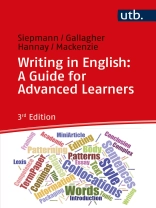Das Werk bietet deutschsprachigen Studierenden und Wissenschaftler*innen, die wissenschaftliche Texte auf Englisch verfassen müssen, Unterstützung. Auch bei der Textrevision und im Englischunterricht für Fortgeschrittene leistet es Hilfestellung. Die Ausgabe wurde gründlich überarbeitet, aktualisiert und erweitert und enthält u.a.
Hinweise zur Verwendung neuer Internet-Technologien.
विषयसूची
Prefaces
Introduction
Module I Organizing ideas into text
Introduction
Chapter 1 The term paper: gearing up to start writing
1.1 The term paper as an argued text
1.2 The three processes of planning, writing proper and editing
1.3 Making the plan
1.4 Using a computer
1.5 Conclusion
Chapter 2 Different types of term paper: Two models
2.1 Term paper as essay or as mini-article
2.2 Quotation and paraphrase
2.3 The literary essay
2.4 The linguistic mini-article
2.5 Conclusion
Chapter 3 Title, Introduction, Body and Conclusion
3.1 The Title
3.2 The Introduction
3.3 The Body sections
3.4 Paragraphs within the Body sections
3.5 The Conclusion
Chapter 4 Getting the paper ready for submission: Editing and formatting
4.1 Editing
4.2 Formal requirements
Bibliography
Module II Building effective sentences
Introduction
Chapter 1 Basic issues in sentence construction
1.1 Sentence construction
1.2 Information packaging
1.3 Sentencing
1.4 Overview
Chapter 2 Information packaging
2.1 Basic grammatical moulds
2.2 The order of information in the clause
2.3 Organizing the starting point
2.4 Establishing a special kind of starting point: framing
2.5 Organizing the end point
2.6 What goes wrong in clause construction
2.7 Overview
Chapter 3 Complex sentences
3.1 Different kinds of sentence
3.2 Clause combining: the basic forms
3.3 Foregrounding and backgrounding
3.4 Complex framing
3.5 Interruption techniques
3.6 Elaborational techniques
3.7 Coordinating and listing
3.8 Problems with sentence length
3.9 Review
Chapter 4 Punctuation
4.1 Commas 1: the principle of semantic unity
4.2 Commas 2: optional use
4.3 Colons
4.4 Semicolons
4.5 Dashes and brackets
4.6 Commas revisited: dealing with comma splices
4.7 Overview
Bibliography
References
Module III Lexis and Grammar
Introduction
Chapter 1 A constructional view of language
Chapter 2 Academic lexis and patterning
2.1 Nouns and noun patterns
2.2 Adjective patterns
2.3 Prepositions and prepositional phrases
2.4 Verbs and verb patterns
2.5 The interface between verb patterning and sentence-building
Chapter 3 From word to collocation
3.1 Words, words, words
3.2 How words go together
3.3 Collocation of semantic-pragmatic features
3.4 Collocational gaps and incompatibilities
3.5 Making creative use of collocation
3.6 The interplay of collocation and patterning
Chapter 4 Rhetorical moves and their lexical realizations
4.1 Stating your topics and objectives
4.2 Reporting, summarizing and paraphrasing
4.3 Expressing opinions and criticizing
4.4 Enumerating ideas and changing the topic
4.5 Topicalizing specific items
4.6 Exemplification
4.7 Comparison and contrast
4.8 Concession
4.9 Cause, reason and explanation
4.10 Consequence and result
4.11 Static relations
Bibliography
Module IV Style
Introduction
Chapter I Style and stylistic competence
1.1 What is style?
1.2 How to achieve stylistic competence
1.3 Academic style
1.4 From non-specialist to specialist text
1.5 Personal style
Chapter 2 The principles of style
2.1 Aptness
2.2 Clarity
2.3 Concision
2.4 Variety
2.5 Elegance
Bibliography
Afterword
Glossary
Index
लेखक के बारे में
Lachlan Mackenzie lehrte Anglistik an der VU Amsterdam.












